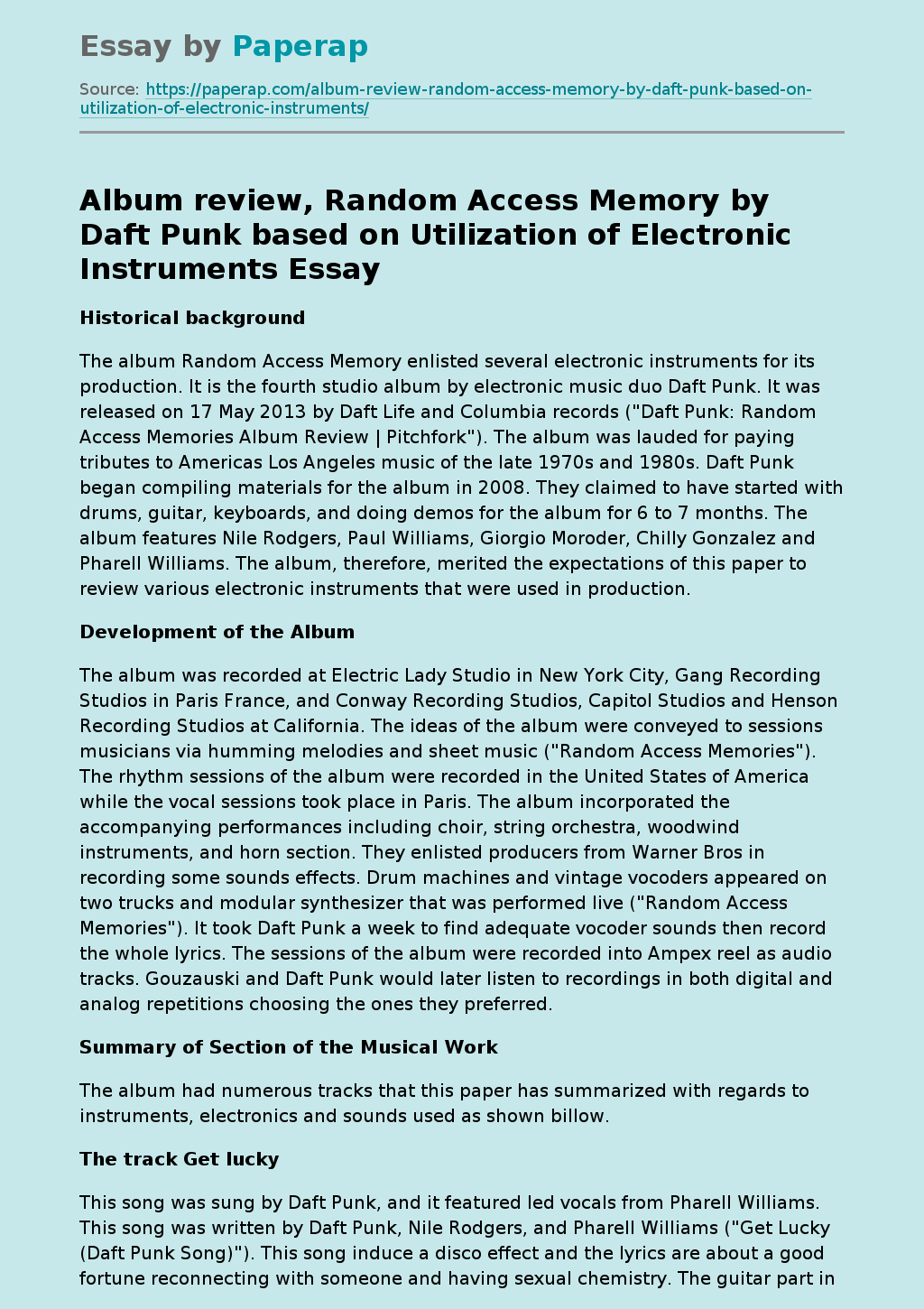DAFT PUNK's Electronic Masterpiece: Random Access Memory
Historical background
The album Random Access Memory enlisted several electronic instruments for its production. It is the fourth studio album by electronic music duo Daft Punk. It was released on 17 May 2013 by Daft Life and Columbia records (“Daft Punk: Random Access Memories Album Review | Pitchfork”). The album was lauded for paying tributes to Americas Los Angeles music of the late 1970s and 1980s. Daft Punk began compiling materials for the album in 2008. They claimed to have started with drums, guitar, keyboards, and doing demos for the album for 6 to 7 months.
The album features Nile Rodgers, Paul Williams, Giorgio Moroder, Chilly Gonzalez and Pharell Williams. The album, therefore, merited the expectations of this paper to review various electronic instruments that were used in production.
Development of the Album
The album was recorded at Electric Lady Studio in New York City, Gang Recording Studios in Paris France, and Conway Recording Studios, Capitol Studios and Henson Recording Studios at California. The ideas of the album were conveyed to sessions musicians via humming melodies and sheet music (“Random Access Memories”).
The rhythm sessions of the album were recorded in the United States of America while the vocal sessions took place in Paris. The album incorporated the accompanying performances including choir, string orchestra, woodwind instruments, and horn section. They enlisted producers from Warner Bros in recording some sounds effects. Drum machines and vintage vocoders appeared on two trucks and modular synthesizer that was performed live (“Random Access Memories”). It took Daft Punk a week to find adequate vocoder sounds then record the whole lyrics.
The sessions of the album were recorded into Ampex reel as audio tracks. Gouzauski and Daft Punk would later listen to recordings in both digital and analog repetitions choosing the ones they preferred.
Summary of Section of the Musical Work
The album had numerous tracks that this paper has summarized with regards to instruments, electronics and sounds used as shown billow.
The track Get lucky
This song was sung by Daft Punk, and it featured led vocals from Pharell Williams. This song was written by Daft Punk, Nile Rodgers, and Pharell Williams (“Get Lucky (Daft Punk Song)”). This song induce a disco effect and the lyrics are about a good fortune reconnecting with someone and having sexual chemistry. The guitar part in the song was created by Nile Rodgers, and the bass and drum part was recorded by Daft Punk and Nathan East. There are two layered guitar parts, rhythm guitaring, and melodic riff.
The track Give life back to music
The song features guitar, drums, and lyrics using vocoders. This track features performance of an instrument as the pedal steel guitar (“Give Life Back to Music”).
The track Lose yourself to dance
This is a disco and funk song with a tempo of 100BPM. The songs evoke the sense of being unified and connected on the dance floor. Vocals are performed by Pharell Williams and it features vocoder instruments by Daft Punk. There is rhythm guitar, bass guitar, and drums.
The track Instant Crush
This song features processed vocals that effect a simple tune that is catchy. Julian Casablanca played the lead guitarist. Daft punk played additional guitar as well as keyboard and synthesizers.
The track Giorgio
Giorgio can be described as a piece of pop drawn from producers experimenting in an epic disco and long form. Moroder personal conversation immensely contributes to the song giving an insight into his musical life history (“Daft Punk: Random Access Memories Album Review | Pitchfork”). This track masterfully moves to a chill-inducing synth, orchestra, and a brilliant guitar from easygoing beats.
The track Touch
The song packs in a show-tune balladry, spacey intro, a sky-scraping choir and a 4/4 disco section with swing music thrills.
The track Fragments of time
DJ Todd Edwards vocals are featured in this track. The melodies embody 1970s musical moments that were revered in the west coast as sounds associated with the Eagles, El Lay and Jackson Browne (“Random Access Memories”).
The track Contact
It is the most old school daft punk song. It is based on a sample, pulling the main riff from the 1981 song Australian band the Sherbs (“Random Access Memories”). Contact was first used in a DJ Mix in 2002 and later finds its way into an album about time and memory. It creates a feeling of time collapsing, showing where Daft Punk can go and where they have been.
Doing it right
Doing it right was described as the only purely electronic piece on the album. The instruments accompaniment consists solely of the modular synthesizer (“Doin’ It Right”). Doing it right is a snare and vocoder driven truck with vocoder loop singing the lyrics and with vocals by Panda Bear.
Conclusion
In conclusion, the album, Random Access Memory is instrumentally rich having used several analog and digital instruments. Songs were first recorded in both in Ampex reel and Pro Tools. The instruments used include the bass, drums, and guitar. Electronic instruments as the modular synthesizer, vocoder loop, drum machine, and keyboard were used in recording the album. Instruments used create the rhythm of the music, and induce the dancing effect. Musical instruments can be used differently as dictated by the occasion.
References
- “Daft Punk: Random Access Memories Album Review | Pitchfork”. Pitchfork.Com, 2019,
- “Doin’ It Right”. En.Wikipedia.Org, 2019,
- “Get Lucky (Daft Punk Song)”. En.Wikipedia.Org, 2019,
- “Give Life Back To Music”. En.Wikipedia.Org, 2019,
- “Instant Crush”. En.Wikipedia.Org, 2019,
- “Lose Yourself To Dance”. En.Wikipedia.Org, 2019,
- “Random Access Memories”. En.Wikipedia.Org, 2019,
DAFT PUNK's Electronic Masterpiece: Random Access Memory. (2019, Dec 10). Retrieved from https://paperap.com/album-review-random-access-memory-by-daft-punk-based-on-utilization-of-electronic-instruments/

